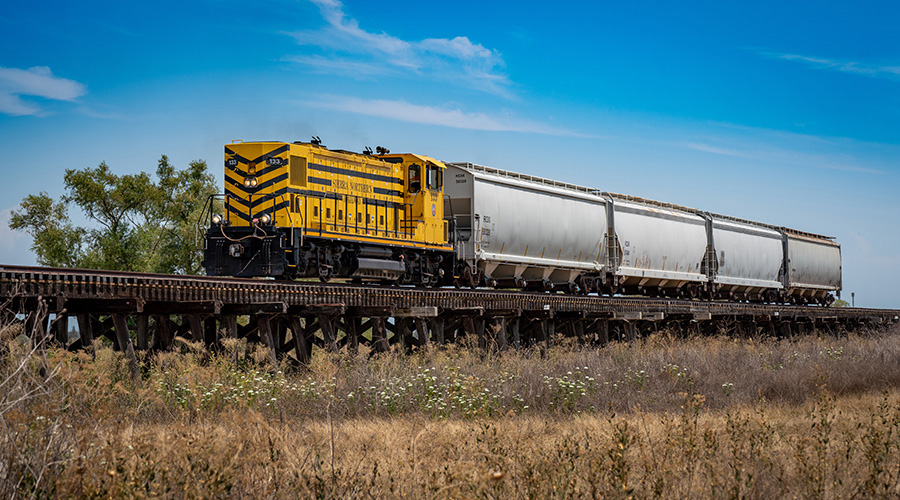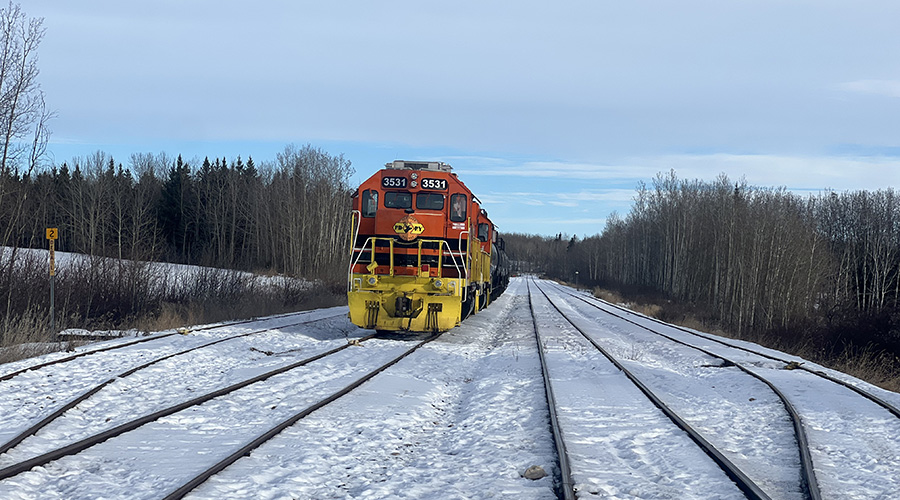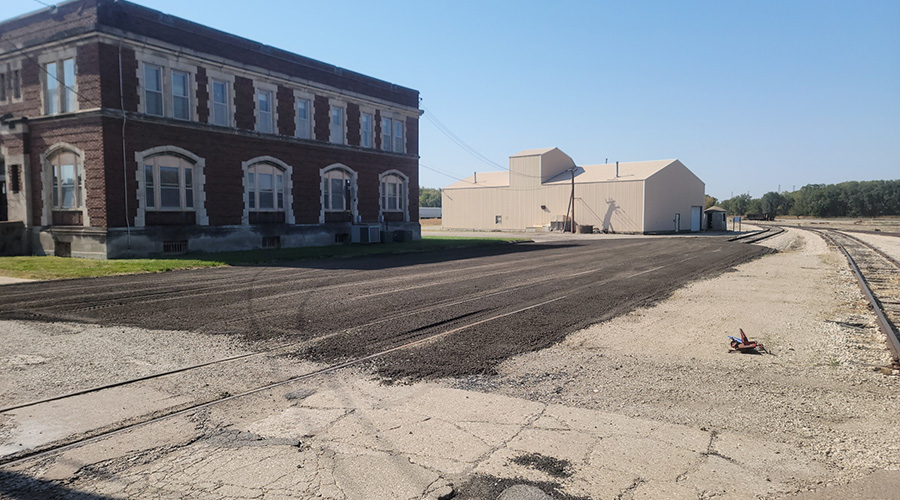From challenges to growth: Short lines share their stories with the STB
9/20/2024
By Julie Sneider, Senior Editor
Six short-line industry leaders — five representing individual railroads or railroad holding companies — this week described for the Surface Transportation Board their strategies to retain and attract more business, as well as deliver more volume to Class Is.
Their stories were one component of the STB’s two-day hearing, held Sept. 16-17, to examine freight-rail growth trends. From the short-line/regional panel, the board learned those railroads’ growth stories as well as the challenges they face in today’s competitive marketplace.
On the panel were Ken Beard III, president and CEO of Sierra Northern Railway; Shannon Drown, vice president of commercial and industrial development, R. J. Corman Railroad Co.; Henry Posner III, chairman of Iowa Interstate Railroad; Marlon Taylor, president of the New York and Atlantic Railway; Kimberly Thompson, vice president of sales and marketing, Genesee and Wyoming Railroad Services Inc.; and Sarah Yurasko, senior vice president, law and general counsel, American Short Line and Regional Railroad Association (ASLRRA).
Yurasko opened the discussion by emphasizing the impact short lines have on the economy.
"Although the typical short line employs about 30 people, serves 18 shippers and transports freight about 50 miles for those customers, we have an outsized impact – particularly in small town and rural America – in getting our customers’ goods to market," she said.
Growth is essential to their survival, she said.
One short line seeking growth opportunities is Sierra Northern. Founded in 1995 the railroad provides rail, intermodal and transloading services across northern and central California; it interchanges with BNSF Railway Co. and Union Pacific Railroad.
 Thanks to CRISI grant-funded rail infrastructure improvements, Sierra Northern Railway is providing faster rail service, using longer trains and bringing onboard new customers, said President and CEO Ken Beard. Ken Beard’s LinkedIn account
Thanks to CRISI grant-funded rail infrastructure improvements, Sierra Northern Railway is providing faster rail service, using longer trains and bringing onboard new customers, said President and CEO Ken Beard. Ken Beard’s LinkedIn accountIn 2017, Beard started looking for state and federal grant opportunities to improve infrastructure that would accommodate growth on the short line. In 2019, the Federal Railroad Administration awarded Sierra Northern $17 million in funding through the Consolidated Rail Infrastructure and Safety Improvements (CRISI) program for a project to replace 90,000 of the rail line's 175,000 rail ties, replace worn curved rail and improve safety at 10 grade crossings on 35 miles of the railroad’s 55-mile Oakdale branch. The funding marked a "major turning point" for the railroad, and crews were able to break ground on those projects despite the pandemic’s arrival in 2020, he said. The grant also enabled the railroad to acquire 116 acres that are now home to the railroad’s Oakdale Division’s transload facility and inland port.
In 2020, Sierra Northern shipped 6,812 carloads and directly served 45 customers; the railroad anticipates shipping 15,100 carloads, including 45 customers over 300 dairy and feed customers via transloading operations conducted over its lines in 2024.
Since obtaining the CRISI, Sierra Northern received $4 million in 2021 to fund the development and demonstration of the first Sierra hydrogen fuel cell switching locomotive that eventually will be integrated into the short line’s regular operations. In July 2023, Sierra Northern received $19.5 million from the state of California to expand the hydrogen fuel cell project to three more switching locomotives. By 2027, Beard anticipates the railroad will have four zero-emission hydrogen-fueled switching locomotives operating in the Sacramento area. The goal eventually is to transform the entire fleet, he said.
 “We know our customers inside and out. That’s what short lines do.” – Shannon Drown, R. J. Corman Railroad Group R. J. Corman Railroad Group
“We know our customers inside and out. That’s what short lines do.” – Shannon Drown, R. J. Corman Railroad Group R. J. Corman Railroad GroupThen in January of this year, Sierra Northern closed a joint loan under the federal Build America Bureau’s RRFI Express program, which enabled the company to develop and expand capacity and rail-car storage by adding four new sidings.
CRISI grants ‘instrumental’ to short-line growth
Later in the hearing, STB board member Michelle Schultz asked the short-line leaders how federal grant programs like CRISI helped smaller railroads achieve growth. Beard said the programs make all the difference to short lines, most of which struggle to afford upgrading aging infrastructure. For example, he described what the CRISI grant meant to Sierra Northern’s operation.
“The importance [of that grant] to that line was that 35 miles of that track was barely manageable,” he said, noting there were speed restrictions and limits on rail cars and how much hazmat materials could be moved on the line.
“This project brought the track up to Class II standards and [from 10 mph] to 25 mph,” he said. “So, what used to take a 12-hour round trip for the crew, now we can serve a customer in about a five-hour round trip. Customers are seeing faster service, we’re taking longer trains and we're able to bring on more customers. ... The CRISI grant was instrumental in allowing us to be able to handle this type of traffic.”
The short line industry’s expertise lies in its ability to provide customer-centric service that results in sustainable growth, said R.J. Corman VP Drown. Corman’s 19 short lines serve 235 customers across 11 states.
 “I strongly believe that you’re the wildcatters out there, saying ‘We can find the business, we can grow the business.’” – STB Chairman Robert Primus Surface Transportation Board
“I strongly believe that you’re the wildcatters out there, saying ‘We can find the business, we can grow the business.’” – STB Chairman Robert Primus Surface Transportation Board“I have personally had the opportunity to work firsthand with many of our customers through shared successes and challenges,” Drown said. “It’s demanding but it’s rewarding. We know our customers inside and out. That’s what short lines do.”
Iowa Interstate’s Posner described his railroad’s relationship with Pattison Co., a family-owned producer of aggregates in northeast Iowa located on Canadian Pacific Kansas City. Working with CPKC, Iowa Interstate was able to help create “geographic competition” – as opposed to intermodal competition – to open new markets for Pattison as they compete in western Iowa with truck-served producers, Posner said, according to written testimony.
“Thanks to rail service we are opening new markets for [Pattison], and at the same time relieving stress on local roads as Pattison’s trucks are used for the last miles as opposed to the complete haul,” he said. “We have been working with Pattison since 2017 and now have five locations on our west end and have grown to over 2,500 cars per year.”
G&W’s Thompson talked about the company’s Puget Sound & Pacific Railroad (PSAP), which operates on 162 track miles between Centralia and Bangor, Washington, and then west to the coast with service to the Port of Grays Habor in Aberdeen. The short line primarily ships agricultural products, lumber and wood and municipal solid waste. PSAP connects with BNSF and UP.
Thompson talked about how short lines work with Class Is, ports and existing and new customers to secure freight for the national rail network and help link to domestic and international markets. Over the next five years, PSAP is projected to increase carload volumes by 50% in two key areas: new import automotive business; and soybean meal shipments, as the short line’s largest ag products shipper expands export capabilities at the Grays Harbor port.
Due to that expected growth, the railroad plans to make more than $50 million in capital investments, including for capacity expansion at the interchanges with BNSF and UP, as well as the addition of two sidings to accommodate incremental unit-train growth, Thompson said.
From challenges come opportunities
STB Chairman Robert Primus told the panel their stories of growth reinforced his view that the strength of the rail network is in its possibility for growth.
“We’re in a soft economy and soft markets and it’s hard to find new business,” Primus said. “But you saw my eyebrows go up when you talked about 50% growth in times like this. I strongly believe that you’re the wildcatters out there, saying ‘We can find the business, we can grow the business.’”
Primus also wanted to know what their key challenges are in trying to reach those opportunities. Yurasko mentioned the California Air Resources Board’s locomotive emissions rule, if allowed to go forward via a U.S. Environmental Protection Agency waiver, would be “devastating” to the short-line industry due to the exorbitant costs, too-short timeframe and lack of existing technology to meet the rule’s deadlines.
“I can't stress enough the concern we have for our members, such as Sierra Northern, who operate in California and are doing great things, making investments in new technology but can’t do it at the speed that has been mandated by the state,” Yurasko said.
Others concurred that the CARB rule would be devastating. But they also talked about the challenge they face bringing growth opportunities to fruition, which includes convincing Class I partners and other stakeholders to come to the table and convincing businesses that have used only trucks to ship their product to switch to rail. It all takes educating the customers and a lot of handholding, panelists said.
Getting to know their customers’ and their business needs is key to a short line’s success, noted New York & Atlantic’s Taylor. Being available to talk to customers directly is important so they know who you are and can help them figure out a solution to their business problem.
“It’s not about extracting a pound of flesh, it’s about being available and understanding [customers’] needs and what you can offer them,” said Taylor.


